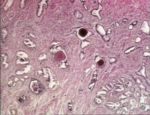Cell Growth Disorders
Jump to navigation
Jump to search
Aplasia
Aplasia also known as agenesis is the complete failure of an organ or part to form during embryogenesis.
Atrophy
Atrophy is a decrease in the size of the cells and organ, occurring after the organ has reached normal size.
Appearance
- Atrophic tissues and organs appear smaller and perhaps paler than usual.
- Microscopy of atrophic tissue shows:
- Cells of a smaller size.
- Inactive appearance.
- A relative increase in the supportive connective tissue.
Causes
- Starvation
- Malabsorption
- Compression
- E.g by a nearby lesion.
- Immobilisation
- Immobilisation of a limb results in atrophy of the muscles.
- Denervation
- Lack of trophic hormones
- Chronic inflammation
- May be idiopathic.
Examples
Serous Atrophy of Adipose Tissue
- Also known as gelatinous atrophy of adipose tissue.
- The fat becomes transparent, watery and severely depleted.
- Occurs as a result of severe debilitation and weight loss.
Brown Atrophy
- A senile change in muscles where they appear brownish rather than reddish in colour.
- Due to the intracytoplasmic accumulation of lipofuscin within the muscle fibres.
- The "wear and tear" pigment.
Hypertrophy
- Hypertrophy is an increase in the size of an organ due to an increase in size of the individual cells.
- The organ also gains in weight.
Types
Functional Hypertrophy
- Occurs in response to:
- An increased physiological need.
- E. g. muscles of the heart and limbs in training.
- An increased demand because of organ dysfunction.
- E.g in cardiac hypertrophy due to a progressively failing heart.
- An increased physiological need.
Compensatory Hypertrophy
- Occurs when one of a paired organ is damaged or lost.
- E.g. the kidney.
Obstructional Hypertrophy
- Hollow organs may become thickened around an obstruction.
- E. g. intestine, bladder, gall bladder.
Hormonal Mediated Hypertrophy
- Anabolic steroids produce hypertrophy of muscle.
- Thyroid hormones have a general hypertrophic effect on tissues.
- Increase protein synthesis within them.
- The heart can become quite hypertrophied in thyroid excess.
- Commonly seen in older cats which often develop hyperthyroidism.
Hypoplasia
- Hypoplasia is a reduction in the size of cells and tissues,.
- Due to a failure to grow to normal size.
- Ranges from mild hypoplasia to almost complete absence.
- Almost complete absence is also called vestigial or rudimentary.
- Aplasia and agensis refer to complete absence of tissue.
- Generally refer to the gross appearance rather than the microscopic appearance.
- Some rudimentary tissue can be seen if searched for carefully.
- Generally refer to the gross appearance rather than the microscopic appearance.
Hyperplasia
- Hyperplasia is an increase in the size of an organ due to an increase in the numbers of cells present within it.
- Hypertrophy and hyperplasia may occur concurrently.
- The hyperplastic response stops when the inciting agent ceases.
- Hyperplastic tissue is more prone to injury by chemicals, and also may be more prone to undergo neoplastic change in some cases.
Causes
- Hormonal stimulation.
- Parathyroid hyperplasia in chronic renal failure.
- Prostatic hyperplasia in older dogs.
- Hyperplasia may also occur as a regenerative response to
- Irritation
- Cell loss
- Injury
Gross Appearance
- Hyperplastic nodules can be seen in a variety of organs in older dogs and cats.
- Particularly the thyroid in cats, and the spleen and liver of dogs.
Histological Appearance
- Hyperplasia is characterised by an increase in the numbers of cells.
- Mitotic activity is not always seen.
- There is some increase in cellular basophilia.
- The cells are well differentiated and tissue structure is normal.
Metaplasia
- Metaplasia is a transformation of one type of tissue into another.
- Occurs solely in:
- Connective tissue
- The metaplastic change id to cartilage and bone in damaged tissue.
- Caesarean scars in the pig are especially prone to osseous metaplasia.
- Epithelium
- Squamous metaplasia of cuboidal or columnar epithelium is quite common.
- Seen in the prostate of dogs under the influence of oestrogens.
- Oestrogens are present in Sertoli cell tumours and in Vit. A deficiency.
- The most striking example is the squamous metaplasia of the oesophageal glands in the chicken.
- Seen in the prostate of dogs under the influence of oestrogens.
- Squamous metaplasia of cuboidal or columnar epithelium is quite common.
- Connective tissue
- Mixed tumours of the mammary gland of the dog are so called because there is proliferation of both the glandular element and the surrounding myoepithelium.
- The myoepithelium can transform into cartilage and bone.
- Some regard this as a metaplastic change.
- The bone formed may even show marrow formation within the spaces between the bony trabeculae.
- The myoepithelium can transform into cartilage and bone.
Dysplasia
- Dysplasia is abnormal growth within a tissue.
- The normal arrangement and pattern of the tissue may be lost.
- The most common example is the renal dysplasia in some breeds of dogs.
- Causes fibrous tracts.
- Because of the reduction in functional tissue, gives a predisposition to renal failure early in life in the more severely affected cases.
Anaplasia
- Anaplasia is a marked and irreversible loss of cellular differentiation with return to a more primitive state.
- Afeature of highly malignant tumours.
- There is no pattern, just a diffuse sheet of cells.
- Both cells and nuclei are of differing sizes.
- There are prominent nucleoli in some nuclei.
